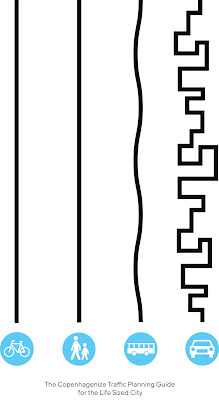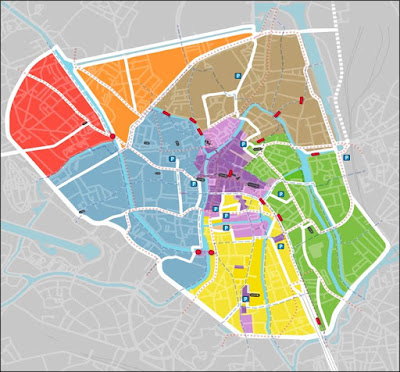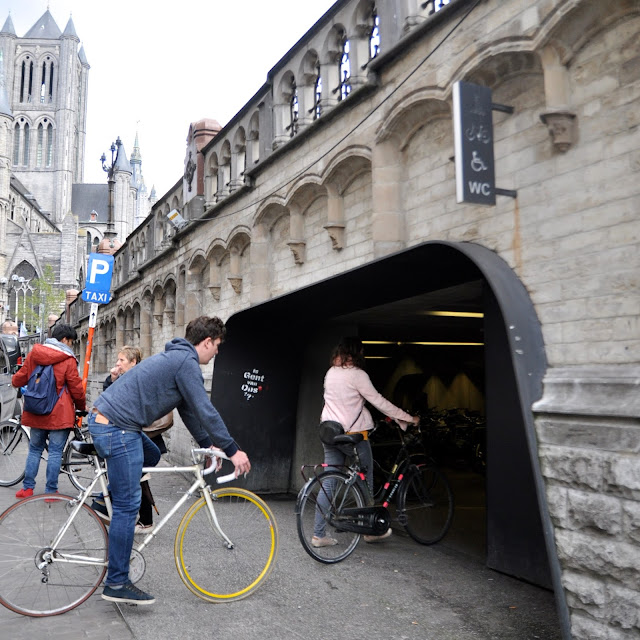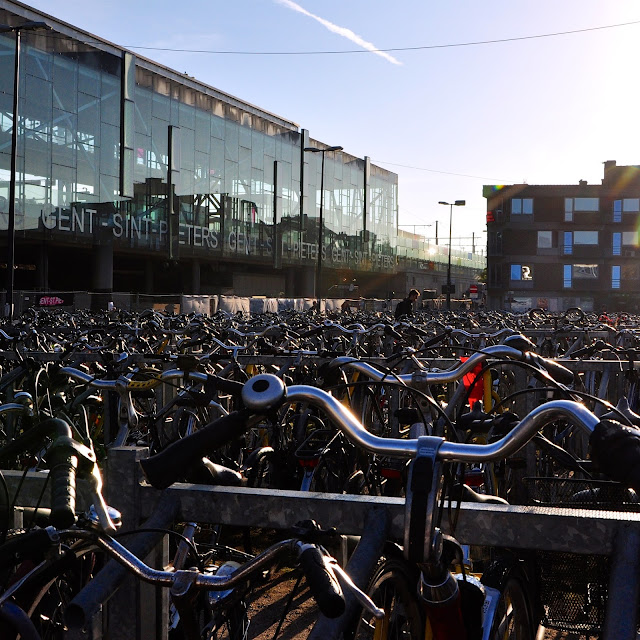 the Copenhagenize Index. But some smaller cities, with less than 600,000 inhabitants deserve to be highlighted for their ambitious measures in favor of urban cycling. Ghent, a Belgian city of around 250,000 inhabitants is one of them.
the Copenhagenize Index. But some smaller cities, with less than 600,000 inhabitants deserve to be highlighted for their ambitious measures in favor of urban cycling. Ghent, a Belgian city of around 250,000 inhabitants is one of them.
Clotilde and Cécile from Copenhagenize Design Co. cycled with Ghent’s Mobility Councillor, Filip Watteeuw to observe the positive impacts of the City’s new circulation plan.
New Circulation Plan Makes Space for Bicycle Users
The new circulation plan, implemented in April 2017, was the outcome of a two-year process where the City of Ghent sought to strengthen an existing sustainable mobility policy and to give back the streets to people. The plan was inspired by the Van Der Berg traffic circulation plan implemented in Groningen, the Netherlands in the 1970s.
The Groningen’s plan divided the city-centre into four sections, forcing car drivers who travel from one section to another to take the city’s inner ring-road, instead of driving through the local streets. This measure aimed to make motorists’ circulation more complicated and to promote other modes of transportation, like cycling.

“A pro-bicycle plan must have some anti-car measures” - Filip Watteeuw
Ghent took this approach a step further by enlarging the city’s pedestrian area and creating six distinct sections with no automobile accessibility between them without using the ring-road.
 |
| Ghent’s new circulation plan : the pedestrian area (dark purple) and the six areas. |
Prior to the implementation of the plan, the City of Ghent recorded that 40% of its rush hour car traffic was due to through traffic – cars not even beginning or ending their journeys in Ghent, but merely passing through. The plan aims to controlling this traffic and thereby improve local streets and enhance urban life.
“You can’t become a cycling city, if you don’t say something about cars. In order to increase the number of cyclists and develop a bicycle culture, it’s necessary to take some anti-car measures. If we get rid of the through traffic, you get fewer cars, more space for pedestrians and cyclists, and infrastructure gets an extra value” asserts Filip Watteeuw.
| Filip Watteeuw, Ghent’s Mobility Councillor and Clotilde Imbert from Copenhagenize Design Co. |
25% more bicycle users vs. 12% less cars
Despite clear goals for local quality of life, the implementation of this ambitious circulation plan has not been a smooth road. In the face of scathing critics, Councillor Watteuw stood firm, and does not regret this political choice to improve living conditions in his city. While leaders of local political parties and some inhabitants opposed to the plan complain about congestion in some streets, a survey conducted by the City revealed that many inhabitants living inside the ring-road consider the streets quieter, with more space for bicycles. People from 25 to 34 years old are the most satisfied.
A noticeable impact of this measure comes from some inhabitants who were quite reticent to this plan, but have already changed their routines by adopting new mobility habits. Generally speaking, 25% of Ghent inhabitants made a decision to change their mobility habits by purchasing an (e-)bike, subscribing to the local public transports or starting car-sharing.
The plan is already having significant impacts on transportation choices. In a year, the impacts of the plan are: 25% increase in bicycle users, 8% increase in public transportation ridership, 12% decrease in car traffic during the rush hour, even 29% less cars on the most important routes within the ring road and 58% in the residential streets. Moreover, 6 interviewed inhabitants out of 10 consider cycling as safer than before. This plan highlights that marketing and public engagement campaigns alone are not enough to make people change their transportation habits, but it is necessary to create the urban conditions which will incentivize changed behaviour.

Although some local shopkeepers worry about decreased revenue, the number of pedestrians in the city-centre did not decline since the adoption of the circulation plan. On the contrary, counters reveal a slight increase from 2% to 10% from August to October 2017 compared with 2016. In order to more accurately evaluate the impacts of this plan, the City has recently decided to increase the number of pedestrian counter locations. In addition to changes in pedestrian traffic, Ghent’s police found the number of traffic accidents have decreased by 25% in the city-centre since the plan implementation. Regarding the air quality, in February 2018 the results of a study will reveal the impacts of the new circulation plan.
4 million Euros were invested the past two years for the preparation and the implementation of the circulation plan, the massive communication related to it and the creation of two shuttles. For reference, a renewal of only one avenue would be more costly.
 |
| To activate the urban life, the City of Ghent arranged life-size places to seat and play. |
Enhanced Park&Ride and even more bicycle infrastructure
For people living in the outskirts of Ghent, the City is also enlarging their Park&Ride offer (from 800 parking spots in 2016 to 3,500 in 2018) in order to allow them to park for free and to switch to bicycles or a free shuttle which will lead them to the city-centre.
Where the car traffic has not been reduced and where cyclists and car drivers can’t share the space, the City knows a plan must still be conducted to improve the standard of cycling infrastructure. During the next six years, the City is going to improve cycling conditions beyond the ring-road.
In conclusion, Ghent’s circulation plan showcases that in a short period smart actions and a rather low budget can lead to positive impacts both in terms of mobility and quality of urban life.
Bicycle infrastructure in Ghent
| Vast waiting area for a two-step left turn. |
| Gently sloped ramps and underpasses allow bicycles to avoid busy car-centric intersections above. |
 |
| Bicycle parking available at the edge of the city’s pedestrian-only zone allows people to park for free in a safe and sheltered place. |
|
Removing space allocated to cars offers more for bicycle parking. |
by Cécile Delannoy, Daniel J. M. Hilhorst, Clotilde Imbert





